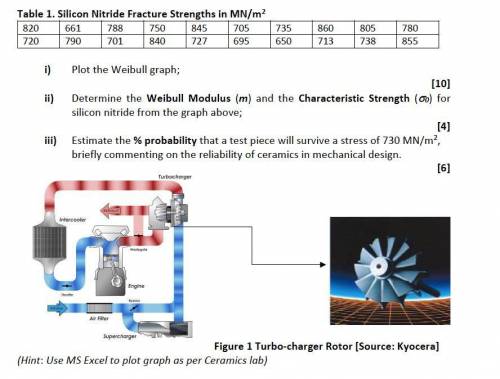
Engineering, 15.12.2020 23:10 alex6toes
Problem1 - Ceramics (attaching table & image under)
(a) Today most turbo charged car engines have their rotors made of silicon nitride (Si3N4) rather than the traditional nickel alloy (Figure 1).
i) Justify this material switch from metals to ceramics by comparing FOUR relevant material properties of silicon nitride with that of the previously used Nickel alloy.
[Compare using a “Table” format and Granta-EduPack to find the property values].
ii) Draw a flow chart to outline the main process steps of the Si3N4 ceramic turbo charger rotor manufacture and assembly, and discuss two microstructural features that must be controlled to within strict limits during manufacture.
(b) 20 silicon nitride (Si3N4) samples from the same batch were 3-point bend tested, the results for the fracture strengths are given in Table 1 below.


Answers: 3


Another question on Engineering

Engineering, 03.07.2019 15:10
Heat is added to a piston-cylinder device filled with 2 kg of air to raise its temperature 400 c from an initial temperature of t1 27 cand pressure of pi 1 mpa. the process is isobaric process. find a)-the final pressure p2 b)-the heat transfer to the air.
Answers: 1

Engineering, 04.07.2019 18:10
Aloaded platform of total mass 500 kg is supported by a dashpot and by a set of springs of effective stiffness 72 kn/m. it is observed that when the platform is depressed through a distance x = 12.5 cm below its equilibrium position and then released without any initial velocity; it reaches its equilibrium position in the shortest possible time without overshoot. find the position and velocity of the loaded platform 0.10 sec. after its release. if a further load of 400 kg is added to the platform, find, i) the frequency of damped vibrations, and i) the amplitude of vibration after 2 complete oscillations, given that the initial amplitude is 15 cm.
Answers: 1

Engineering, 04.07.2019 18:10
Abrake has a normal braking torque of 2.8 kip in and heat-dissipating cast-iron surfaces whose mass is 40 lbm. suppose a load is brought to rest in 8.0 s from an initial angular speed of 1600 rev/min using the normal braking torque; estimate the temperature rise of the heat dissipating surfaces.
Answers: 3

Engineering, 04.07.2019 18:10
Apipe with an outside diameter of 15 cm is exposed to an ambient air and surrounding temperature of -20°c. the pipe has an outer surface temperature of 65°c and an emissivity of 0.85. if the rate of heat loss from the pipe surface is 0.95 kw per meter of length, the external convective heat transfer coefficient (h) is: (a) 12.5 w/m"k (b) 18.6 w/mk (c) 23.7 w/mk (d) 27.9 w/mk (e) 33.5 w/mk
Answers: 1
You know the right answer?
Problem1 - Ceramics (attaching table & image under)
(a) Today most turbo charged car engines ha...
Questions




Social Studies, 03.10.2019 13:10


Chemistry, 03.10.2019 13:10




Physics, 03.10.2019 13:10

History, 03.10.2019 13:10

Health, 03.10.2019 13:10

Mathematics, 03.10.2019 13:10



Mathematics, 03.10.2019 13:10

History, 03.10.2019 13:10

Arts, 03.10.2019 13:10


Chemistry, 03.10.2019 13:10



